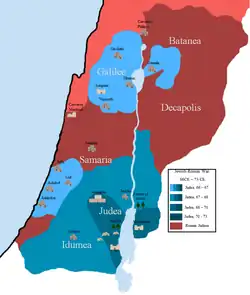Judean Provisional Government הממשלה הזמנית ביהודה | |
|---|---|
| 66 CE–68 CE | |
 Map of the changing territory held by Jewish forces during the revolt | |
| Status | Unrecognized state (66 CE–68 CE) |
| Capital | Jerusalem |
| Common languages | Old Aramaic (official),[1] Koine Greek Biblical Hebrew (liturgical) |
| Religion | Second Temple Judaism |
| Demonym(s) | Judean |
| Government | Provisional Government |
| Head of State | |
• 66–68 CE | Joseph ben Gurion |
| Historical era | First Jewish-Roman War |
• Proclaimed | 66 CE |
| 68 CE | |
| Currency | Shekel |
| Today part of | Israel |
| History of Israel |
|---|
 |
|
|
The Judean provisional government was a short-lived de facto governing entity in Judea, which was established during the Great Revolt in the year 66 CE by Judean rebel forces of the Pharisee and Sadducee parties. It aimed to create and govern a full Judean state, although its influence was concentrated in Jerusalem. The government functioned until the Zealot Temple Siege in the year 68 CE, when most of its leaders were massacred in the inter-rebel struggle.[2][3][4][5]
History
Formation
Following the Battle of Beth Horon which saw the defeat of Gallus in 66 CE, the People's Assembly was called under the spiritual guidance of Simeon ben Gamliel and thus the Judean provisional government was formed in Jerusalem. Ananus ben Ananus, the former High Priest of Israel, was appointed one of the heads of the government and began reinforcing the city, with Joshua ben Gamla also taking a leading role. Yosef ben Matityahu was appointed the commander in Galilee and Golan, while Yosef ben Shimon was appointed commander of Jericho.[6] John the Issene was appointed commander of Jaffa, Lydda, Ammeus-Nikopolis and the whole Tamna area.[6] Eliezar ben Hananiya was appointed the joint commander in Edom together with Joshua ben Zafia, with Niger the Perean, a hero during the Gallus campaign, under their command. Menasseh was appointed to cover Perea and Yohanan ben Hananiya allocated Gophna and Acrabetta.[6]
Coinage

According to Cecil Roth, the new government began almost immediately to mint silver coins which, although they were "not distinguished either in design or execution," were of symbolic importance in the struggle for independence both because they were devoid of the name, reign year and image of the Roman emperor, and because they were made of silver. Silver coinage was the privilege of Imperial mints; the bronze coins that provinces were allowed to mint were a symbol of the subjugation of provinces to Rome.[8] There is broad scholarly agreement that coins issued by the Judean government during the Revolt use an archaic Hebrew script and Jewish symbols including pomegranate buds, lulavs, etrogs, and phrases including "Shekel of Israel," and "The Freedom of Zion" (חרות ציון Herut Zion,) as political statements intended to rally support for independence.[9]
Disbandment
The provisional government became obsolete in the year 68, when inter-rebel strife led to the killing of most of its members. According to the historian Josephus, Ananus incited the people to rise up against the Zealots who were in control of the Temple. The forces of Ananus besieged the Zealots who held the Temple. When John of Giscala led the Zealots to believe that Ananus had contacted the Roman General Vespasian for assistance in retaking control of all Jerusalem, the Zealots, driven to desperation, asked the Edomites (Idumeans) for assistance in preventing the delivery of the city to the Romans. When the Edomites arrived, the Zealots opened the gates of Jerusalem to them, and the Edomites slaughtered ben Hanan's (Ananus ben Ananus) forces, killing him as well.
After freeing the Zealots from the Temple, the Edomites and Zealots massacred the common people. Remnants of the rebel government summoned the peasant faction headed by Simon bar Giora to Jerusalem, in order to stand against the rampaging Zealots. While the charismatic Bar Giora took over much of the city, he did not attempt to restore the government, rather ruling by himself in a despotic manner. Bitter fighting between Zealot factions and Bar Giora continued until the Roman siege of 70 CE.
Recognition
The rebel Judean government was not recognized at any time by the Roman Empire and in fact enjoyed limited recognition amongst the rebel factions. The Jerusalem-based rebel government had little authority in the Galilee, where locals were not satisfied with the fact that a non-local, Joseph ben Matityahu, was appointed a regional commander, marginalizing John of Gischala and Justus of Tiberias, who rejected his authority.[10] Furthermore, the Judean-based Zealots, the peasantry and most Idumean factions were never under the direct control of the government. Kingdom of Adiebene however did provide direct support to it, dispatching significant supplies and some 500 armed men in support.
Notes
References
- ↑ Muraoka, T. (1992). Studies in Qumran Aramaic. Peeters. p. . ISBN 978-9068314199.
- ↑ A Chronology of the Life of Josephus and his Era
- ↑ Westera, Rick. "Historical Atlas of Eastern Mediterranean (January 69 AD): Simon bar Giora". Omniatlas. Retrieved 2023-10-29.
- ↑ Needleman, Emma. "Tisha B'Av Explained". blog.jewishphilly.org. Retrieved 2023-10-29.
- ↑ "The Jewish Revolt Against Rome:The War of 66-70 C.E." Commentary Magazine. 1959-06-01. Retrieved 2023-10-29.
- 1 2 3 Ben Zion, S. A Roadmap to the Heavens: An Anthropological Study of Hegemony Among Priests. p45.
- ↑ "Silver Shekel from the First Jewish Revolt, 66–70 CE". The Center for Online Judaic Studies. Archived from the original on 9 April 2013. Retrieved 6 March 2011.
- ↑ Roth, Cecil. "The Historical Implications of the Jewish Coinage of the First Revolt." Israel Exploration Journal 12, no. 1 (1962): 33-46.
- ↑ Ariel, Donald T. "Judaea and Rome in Coins, 65 BCE - 135 CE.", The Numismatic Chronicle 174 (2014): 385-91. https://www.jstor.org/stable/44710215.
- ↑ Bradley W. Root. First Century Galilee: A Fresh Examination of the Sources. Mohr Siebeck. 2014.